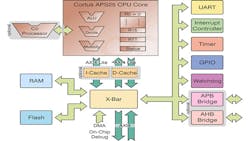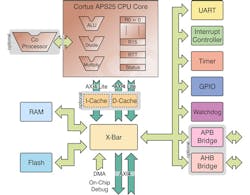Wearable technology presents packaging challenges (see “Wearable Technologies Present Packaging Challenges”) but the use of custom ASICs can often reduce the effort needed to create new products. ARM and Imagination MIPS cores are just one way to go. Cortus is another.
Cortus APS23 and APS25 (Fig. 1) 32-bit cores are now available to ASIC designers. These are small cores with a RISC instruction set that includes 16-, 24- and 32-bit instructions. This provides a 16% improvement in code size over their prior cores. The older cores are assembler and C/C++ compatible although the new cores do work with existing Cortus peripheral IP. The new cores also the AXI4 Lite/AXI4 interface. The APS25 supports multicore designs.
The cores are designed to provide security in a connected environment. They support secure execution by keeping secure code in a separate area. Cortus also supports redundancy using lockstep, dual core solutions.
The APS23 is the smaller of the litter with a 3-stage pipeline. It is on part with Cortex-M0/M3 cores. Like the APS25, it supports execution from RAM that is normally faster than flash.
The APS25 has a 5-stage pipeline and address code and data caches. It also runs at 2.5 times the clock speed of the APS23. The APS25 is on par with ARM Cortex-M3/R cores. This core also supports a 16-bit DSP coprocessor. This is done via the extensible instruction set support by both cores.
The cores are supported by a GNU-based tool suite. This includes an Eclipse-based IDE. There are the usual set of profiler and debugging tools included. There is third party support including RTOS support such as FreeRTOS.
ARM has dominated the 32-bit standard core space for a while now but ASIC designers often need an edge. Technology like the Cortus APS23 and APS25 may be what they need.
About the Author
William G. Wong
Senior Content Director - Electronic Design and Microwaves & RF
I am Editor of Electronic Design focusing on embedded, software, and systems. As Senior Content Director, I also manage Microwaves & RF and I work with a great team of editors to provide engineers, programmers, developers and technical managers with interesting and useful articles and videos on a regular basis. Check out our free newsletters to see the latest content.
You can send press releases for new products for possible coverage on the website. I am also interested in receiving contributed articles for publishing on our website. Use our template and send to me along with a signed release form.
Check out my blog, AltEmbedded on Electronic Design, as well as his latest articles on this site that are listed below.
You can visit my social media via these links:
- AltEmbedded on Electronic Design
- Bill Wong on Facebook
- @AltEmbedded on Twitter
- Bill Wong on LinkedIn
I earned a Bachelor of Electrical Engineering at the Georgia Institute of Technology and a Masters in Computer Science from Rutgers University. I still do a bit of programming using everything from C and C++ to Rust and Ada/SPARK. I do a bit of PHP programming for Drupal websites. I have posted a few Drupal modules.
I still get a hand on software and electronic hardware. Some of this can be found on our Kit Close-Up video series. You can also see me on many of our TechXchange Talk videos. I am interested in a range of projects from robotics to artificial intelligence.


